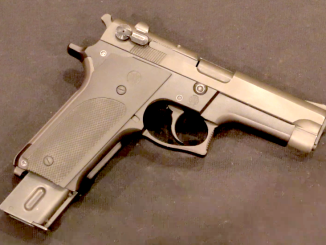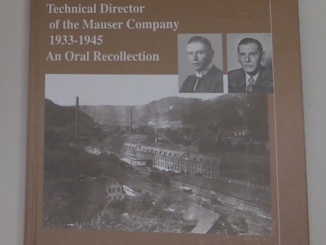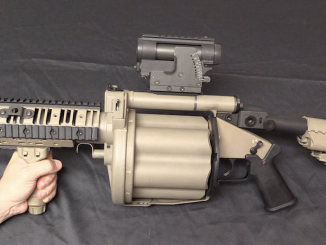I’ve written a fair amount about the BAR, so I won’t belabor the point here – if you would like more to read, check out my general history of the BAR and comparison between the M1918 and M1918A2. What I’d like to add to that today is some video I took with an Ohio Ordnance M1918A3 semiauto-only model. Between talking about the history of the gun, its use and modifications, and then disassembling it and examining the operating mechanism, this turned into a somewhat longer video than I usually prefer – but hopefully folks will find it interesting and informative (and maybe even entertaining)…
Related Articles

Prototype
Replacing Beretta: the S&W XM10 Trials Pistol
When the US adopted the Beretta Model 92 as the new M9 standard issue handgun in 1985, it was not without controversy. In particular, there was a scandal of cracked and broken M9 slides shortly […]

Book review
Book Review: Ott-Helmuth von Lossnitzer, Technical Director of the Mauser Company 1933-1945
Ott-Helmuth (Otto, after he emigrated to the US) von Lossnitzer was a remarkable firearms engineer. He served through World War One as a machine gunner, gaining extensive experience with a variety of different machine guns […]

Grenade Launcher
Milkor M32 and M32A1 40mm Grenade Launchers
The USMC adopted the Milkor USA M32A1 rotary multiple grenade launcher (MGL) in 2012. The history of this weapon goes back to South Africa, where designer Andries Piek was inspired to create it after building […]

It is one classy looking gun.
Would the bipod fit on the gas tube facing backwards, so it folds forward? It looks like there might be enough clearance between it and the barrel and some kind of shim on the bottom could make up the tube size difference. Great video, it was nice to see the disassembly too.
OMG Ian you screwed up the take down completely.
1. Remove trigger group.
2. Push the rear of the recoil spring forward and rotate 90 deg to remove. (reason it is knurled)
3. Pull oprod to the rear then remove the gas tube (no spring pressure to fight).
4. Remove the charging handle like you did.
5. Remove the hammer and then the op rod.
6. You do not have to remove the spring on the bolt retainer on the left side of the receiver, it has a notch on the outside so that you use the universal tool or screw driver to pry it out far enough that the bolt drops out of the bottom (the reason there is that notch cut into the receiver on the outside). The bolt retainer never should be removed while in the field.
See this video of it done slightly wrong but closer to right than yours
http://youtu.be/rUaGI3OdGOA
See this video of how a full auto works
http://youtu.be/xVzWu1CqGf4
Just went through the US BAR manual and they do not take the spring out when I say to do it. Not sure why but this is oen of the differences between my Swedish Bar and the US one.
Thanks for adding references!
Just short of passing judgements, this is not the easiest operating system to disassemble, but it ought to be excused for being one of the first of its kind.
Found som info on the Swedish B.A.R that someone might find intresting.
http://gotavapen.se/gota/artiklar/kg/swedish_kg2.htm
You might try my website, bit more specific info on the gun (I own one).
http://home.comcast.net/~sfischer397/swedishbar/index.htm
what is the use for the flappy bit on the back of the stock? Keep it from falling down from your shoulder?
To help control the recoil… Apparently. Or at least, that’s what it’s for on the L86A2 LSW, which has a similar thing. Pointless really.
I don’t think that John Moses Browning would have a problem with polymer stocks, and aluminum receivers, things that didn’t exist in his day.
It is amazing what he did with the newly invented stuff called “smokeless powder”
What’s your source on the CSRG being designed for walking fire? IIRC, walking fire was primarily a British and American idea, and the French under Petain favored a fairly modern-looking suppress-and-maneuver tactic. I don’t recall seeing any Chauchat ancillaries designed for walking fire, and it had a bipod, which wouldn’t have been useful if it were employed that way.
As to the CSRG and “Walking Fire”, the French may not have invented it, but the Troops were sure trained in its use…to the extent that the Pourvoyeur ( the ammo resupply guy,) would take a full magazine from the Gunner’s Back-Pack ( side flap), remove the empty with one hand, fit the full mag with the other, and secure it in place, all “en Marche”, and then secure the empty into his own accoutrements. As soon as the New Mag was clicked in, the Gunner would continue firing…
Nice idea, but not really practical under German MG fire….but then the idea of the CSRG tactically, was Suppressive Fire, to keep the Germans’ heads down during an assault… but a 20 round Mag was hardly enough for this… In the First World War, they had no ideas of what we called “Fire and Movement” back in Vietnam days.
Read all about CSRG design, tactics and use in “Honour Bound” (Collector Grade Publications, Canada).
Doc AV
Dr. Vallati,
I desperately need a copy of Honor Bound, but they are fairly difficult to get a hold of.
There are a bunch of new copies on Amazon right now – check the link here:
https://www.forgottenweapons.com/book-review-honour-bound-the-chauchat-machine-rifle/
I am not sure if it is entirely correct to say that in WW1 they had “no idea” of fire and movement. Both the late war British infantry and German “stormtrooper” tactics can be seen as embryonic forms of “modern” infantry tactics. The British employed the Lewis LMG together with Stokes mortars to a good effect, and of course the Germans had their SMGs, although they lacked a proper LMG (which they were acutely aware of, hence the MG 08/18). Unfortunately only the Germans seem to remembered all the lessons learned from WW1 when WW2 started.
Actually, I have to correct myself: not even the Germans remembered all the WW1 lessons, since they clearly underestimated the utility of submachine guns in the 1930s ,and during the early years of WW2 German infantry did not have as many SMGs as they could have used.
You forgot to mention one of the biggest improvements of the FN-D over the BAR: quick change barrels. Still a great video.
I really like that bolt idea, on the automatic one, how it acts as a hammer etc groovy.
In the 1960’s we got to watch Combat! with Vic Morrel. Little John with the BAR. The biggest guy assigned to an infantry plt being designated the BAR guy, next biggest, his assistant gunner (carrying more ammo in mags. http://www.ebay.com/itm/WWI-US-ARMY-AEF-FM-BAR-RIFLEMAN-CARTRIDGE-AMMO-BELT-by-PB-CO-STAMPED-AND-DATED-/321436611259?pt=LH_DefaultDomain_0&hash=item4ad71d72bb And considering that the assistant gunner had a rifle and his ammo, a assistant BAR gunner’s web belt with mag pounches for BAR mags, plus maybe 1 or 2 bandoliers of 5 rd stripper clips that he had to use to reload the empty mags, (and possibly a full can of bandoliers. plus any of the fire team riflemen carrying a box of bandolies to share between riflemen and the BAR fire support team, The troops were overladen.
Madsen machinegun
Contrary to what you said in the video, Ian, the Madsen MG was used heavily by germany in WW1 and they tried to get as many as they could and captured examples were pressed into service instantly. It was just never formally added to the Kaiser’s armoury. The Madsen MGs were mostly concentrated in special so called “musket” units. But the Danes were trying to be neutral in the Great War so were reluctant to sell as many as the OHL would have liked, because it went well with the new stormtrooper tactics.